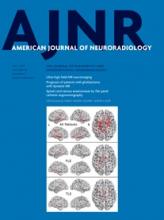Review ArticleReview Articles
Open Access
Ultra-High-Field MR Neuroimaging
P. Balchandani and T.P. Naidich
American Journal of Neuroradiology July 2015, 36 (7) 1204-1215; DOI: https://doi.org/10.3174/ajnr.A4180
P. Balchandani
aFrom the Translational and Molecular Imaging Institute (P.B.)
bDepartment of Radiology (P.B., T.P.N.), Icahn School of Medicine at Mount Sinai, New York, New York.
T.P. Naidich
bDepartment of Radiology (P.B., T.P.N.), Icahn School of Medicine at Mount Sinai, New York, New York.

REFERENCES
- 1.↵
- Clow H,
- Young IR
- 2.↵
- Atlas SW
- 3.↵
- 4.↵
- Duyn JH
- 5.↵
- Uğurbil K,
- Adriany G,
- Andersen P, et al
- 6.↵
- Fatterpekar GM,
- Naidich TP,
- Delman BN, et al
- 7.↵
- Naidich TP,
- Duvernoy HM,
- Delman BN, et al
- 8.↵
- Duvernoy H,
- Cattin F,
- Naidich TP, et al
- 9.↵
- 10.↵
- Kollia K,
- Maderwald S,
- Putzki N, et al
- 11.↵
- Thomas BP,
- Welch EB,
- Niederhauser BD, et al
- 12.↵
- 13.↵
- 14.↵
- Haacke EM,
- Mittal S,
- Wu Z, et al
- 15.↵
- Sanchez-Panchuelo RM,
- Besle J,
- Beckett A, et al
- 16.↵
- Duong TQ,
- Yacoub E,
- Adriany G, et al
- 17.↵
- Yacoub E,
- Duong TQ,
- Van De Moortele PF
- 18.↵
- 19.↵
- Mayer D,
- Spielman DM
- 20.↵
- 21.↵
- 22.↵
- 23.↵
- 24.↵
- 25.↵
- 26.↵
- 27.↵
- 28.↵
- Thulborn KR,
- Davis D,
- Snyder J, et al
- 29.↵
- 30.↵
- 31.↵
- 32.↵
- Qiao H,
- Zhang X,
- Zhu XH, et al
- 33.↵
- 34.↵
- 35.↵
- Madelin G,
- Kline R,
- Walvick R, et al
- 36.↵
- 37.↵
- 38.↵
- Zeineh MM,
- Parvizi J,
- Balchandani P, et al
- 39.↵
- Grabner G,
- Nöbauer I,
- Elandt K, et al
- 40.↵
- 41.↵
- Eapen M,
- Zald DH,
- Gatenby JC, et al
- 42.↵
- Breyer T,
- Wanke I,
- Maderwald S, et al
- 43.↵
- Madan N,
- Grant PE
- 44.↵
- 45.↵
- 46.↵
- Thulborn KR,
- Davis D,
- Adams H, et al
- 47.↵
- 48.↵
- Ouwerkerk R,
- Bleich KB,
- Gillen JS, et al
- 49.↵
- 50.↵
- Park MJ,
- Kim HS,
- Jahng GH, et al
- 51.↵
- 52.↵
- 53.↵
- Hammond KE,
- Metcalf M,
- Carvajal L, et al
- 54.↵
- Ge Y,
- Law M,
- Herbert J, et al
- 55.↵
- Ge Y,
- Zohrabian VM,
- Grossman RI
- 56.↵
- Quinn MP,
- Kremenchutzky M,
- Menon RS
- 57.↵
- 58.↵
- 59.↵
- Drevets WC
- 60.↵
- Wang Z,
- Neylan TC,
- Mueller SG, et al
- 61.↵
- Drevets WC
- 62.↵
- Price JL,
- Drevets WC
- 63.↵
- McKinnon MC,
- Yucel K,
- Nazarov A, et al
- 64.↵
- 65.↵
- 66.↵
- Liao Y,
- Huang X,
- Wu Q, et al
- 67.↵
- Miguel-Hidalgo JJ,
- Baucom C,
- Dilley G, et al
- 68.↵
- Cotter D,
- Mackay D,
- Chana G, et al
- 69.↵
- Si X,
- Miguel-Hidalgo JJ,
- O'Dwyer G, et al
- 70.↵
- Vaughan JT,
- Garwood M,
- Collins CM, et al
- 71.↵
- 72.↵
- 73.↵
- Garwood M,
- DelaBarre L
- 74.↵
- 75.↵
- 76.↵
- 77.↵
- 78.↵
- 79.↵
- 80.↵
- 81.↵
- 82.↵
- 83.↵
- 84.↵
- 85.↵
- 86.↵
- 87.↵
- 88.↵
- 89.↵
- 90.↵
- 91.↵
- 92.↵
- 93.↵
- 94.↵
- 95.↵
- Robitaille P-M,
- Berliner LJ
- Robitaille P-M
- 96.↵
- Shellock FG
- 97.
- 98.
- Uludağ K,
- Müller-Bierl B,
- Uğurbil K
- 99.
- Solomon I
- 100.
- 101.
- 102.↵
- Van Leemput K,
- Bakkour A,
- Benner T, et al
- 103.↵
In this issue
American Journal of Neuroradiology
Vol. 36, Issue 7
1 Jul 2015
Advertisement
P. Balchandani, T.P. Naidich
Ultra-High-Field MR Neuroimaging
American Journal of Neuroradiology Jul 2015, 36 (7) 1204-1215; DOI: 10.3174/ajnr.A4180
0 Responses
Jump to section
Related Articles
- No related articles found.
Cited By...
- High-Field 7T MRI in a drug-resistant paediatric epilepsy cohort: image comparison and radiological outcomes
- MULTIMODAL GRADIENTS UNIFY LOCAL AND GLOBAL CORTICAL ORGANIZATION
- Phenotyping Superagers Using Resting-State fMRI
- Application of 7T MRS to High-Grade Gliomas
- Cortical Depth-Dependent Modeling of Visual Hemodynamic Responses
- Emerging Use of Ultra-High-Field 7T MRI in the Study of Intracranial Vascularity: State of the Field and Future Directions
- Ultra-high field MRI reveals mood-related circuit disturbances in depression: A comparison between 3-Tesla and 7-Tesla
- Investigating resting-state functional connectivity in the cervical spinal cord at 3T
- 7T MRI for neurodegenerative dementias in vivo: a systematic review of the literature
This article has not yet been cited by articles in journals that are participating in Crossref Cited-by Linking.
More in this TOC Section
Similar Articles
Advertisement











